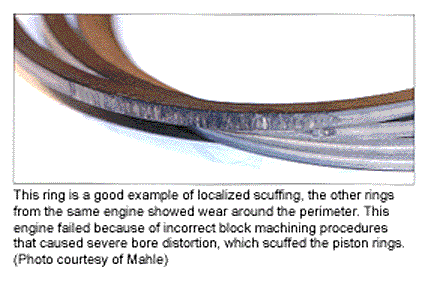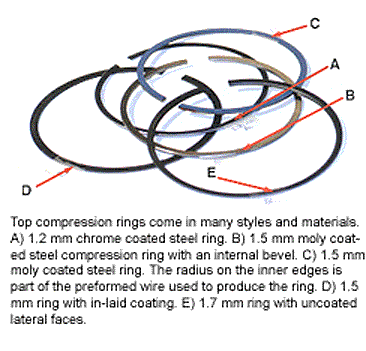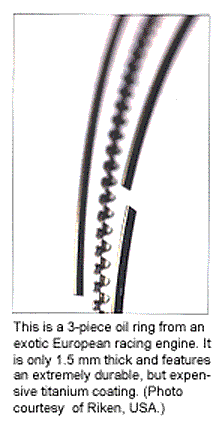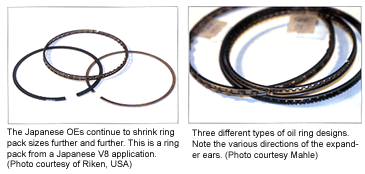“He who breaks a thing to find out what it is, has left the path of wisdom.” – Gandalf, Fellowship of the Rings.
This is certainly not the case with piston ring technology, although Gandalf from the Lord of The Rings never directed his comments towards engine builders or piston ring manufacturers. Piston ring manufacturers have been “breaking things” apart for years to find out what it is and how to make it better. This, in turn, has made us all wiser.

OEMs are moving toward smaller, lighter materials in piston rings to reduce friction and improve sealing. The push for higher performance and lower emissions, especially in the past decade, has resulted in the need for piston rings to withstand higher combustion temperatures and pressures.
There are many styles of rings and each ring manufacturer seems to have its own special or patented design. Whether you’re building a low emission production engine or a high-powered drag race engine, what you choose for rings will have significant impact on the engine’s performance and durability.
While gray cast iron is still cost-effective and commonly used in rebuilding older-style engines, it is more brittle and can break under extreme loads, and it can anneal or micro-weld to the piston much easier than a coated ring. Barry Rabotnick, Federal-Mogul, Speed Pro, says that while cast iron rings are okay for some production engines, they will not last long in a racing engine. Rings treated with some type of coating will hold up much better under the heat and pressure of a performance engine.
“Ductile iron and plasma-moly coated rings can take the heat and pressure without deforming,” says Rabotnick. “Our ‘Hellfire’ ring (heat-treated ductile iron) is for the most extreme combustion environments such as those seen in Pro Stock.”
Rabotnick says that while some engine builders try to use the best rings possible, such expense is not always necessary “Some guys want to use the latest, highest quality material for an engine that doesn’t necessitate that type of material. If you’re building a Pro Stock or Cup engine – something high end – then you’ll need all the technology to get every little bit of power. If you’re building a standard production engine it would be overkill.”
According to Scott Gabrielson, Federal-Mogul’s Sealed Power division, who has been dubbed by Federal-Mogul the real “Lord of the Rings,” OEM and performance engines use smaller ring packs in both cross-sections (width and radial thickness) for different reasons:
“The OE does it to increase fuel mileage and reduce emissions; the performance market is going to smaller rings because less friction equates to more horsepower,” says Gabrielson.
Another reason is the way engines are being designed today, he continues. “Vehicle manufacturers are trying to make engines as lightweight and compact as possible so the car weighs less and is more aerodynamic. As a result, OEs have reduced the deck of the engine (for better aerodynamics), leaving less room for the rings. There’s only so much ring land area left to be able to put the rings in today’s engines.”
According to Jack Bishop of NPR America (Nippon Piston Rings), because they are constantly looking for better fuel mileage and lower emissions, the Japanese OEMs keep moving the rings up and continue to develop smaller ring sizes for the entire ring pack. “They are trying to develop an engine that will get 70 mpg, so they are shrinking ring sizes even more,” Bishop says. “Some designs go as small as 0.7 mm for the top rings and as small as 1.5 mm for the oil ring.”
Although the differences between the Japanese and domestic carmakers used to be many, Bishop believes they are meeting somewhere in the middle now. Although he says that European and domestic car makers believe current ring sizes are about as thin as they can go without running into other problems, the Japanese aren’t so convinced and are likely to keep going thinner.

By moving the rings up in the combustion chambers manufacturers have reduced the crevice volume, which in turn reduces hydrocarbons from unburned fuel. “Because the ring is being moved up in OE and because of the pressures and temperatures of performance engines, a high-strength material ring is an absolute must in the top groove,” Sealed Power’s Gabrielson stresses. “Whether it’s a high-grade ductile iron or some sort of high-carbon steel, it needs to withstand its environment.”
Steel Rings
All of the experts agree that ring pack sizes are getting smaller and smaller. One of the ways ring manufacturers are meeting demands from automakers and racing teams to reduce drag and improve sealing is by increasing the use of steel rings.
According to Dave Garmenn, Clevite Engine Parts, makers of Perfect Circle piston rings, steel is being utilized more by engine makers because of its strength, so you can make a thinner ring that maintains the same durability.
Clevite’s Tod Richards agrees, saying that one of the biggest benefits of steel is that a moly coating has a tendency to adhere to the ring a little better because the channel that holds the plasma-moly is formed into the groove when it is being made, rather than machined into it later. “Basically, there’s a burr-free channel for the moly to sit in,” says Richards.
Heat transfer is another benefit of steel over cast iron/ductile iron, according to both Garmenn and Richards. “You cannot move an iron or ductile ring up as far as the OEs are putting them because of heat issues,” notes Richards. “So theoretically steel will transfer more heat to the cylinder wall with less problems than with cast/ductile iron.”
Reducing drag and weight has been an important element in the evolution of ring sizes and materials. “Back in the day, the OEs were running 5/64?, 5/64?, 3/16? ring packs in the old V8 engines,” says Richards. “In today’s new technology-driven engines the OEs are now using 1.2 mm, 1.5mm, 2.8mm or a 1.0mm, 1.2mm, 2.8mm ring set. You essentially lose a ton of drag when you go to the thinner ring packs, therefore increasing the engine’s efficiency.”
Japanese engine makers led the trend into steel rings: Honda, Nissan and Toyota have been using steel compression rings since the 1970s. The basic theory is that the metallurgical properties of steel allow it to be more conformable to the cylinder wall without increasing tension.
Don McNulty, president of Riken Corp., the U.S. arm of Japan’s Riken Corp., which produces around 36 million piston rings a year in its plants worldwide (and is part of a joint venture called Allied Ring Corp., which includes Dana Corp., to produce steel piston rings for OEs and the aftermarket in North America), says that steel tends to be more robust, so rings can be made smaller. The smaller the mass, the more conformable it is. “During the old iron days it was very common to have 1.5 mm top rings, but with steel being more robust we can go thinner. What used to be 1.5 mm went down to 1.2 mm, and what was 1.2 mm are now going to 1.0 mm. In certain motorcycle engines and some automotive engines we’ve even seen the use of 0.8 mm rings,” explains McNulty.
“If the ring is more conformable at lower friction, you’ll get better sealing without the penalty of friction at low tension. If you have an iron ring you have to ratchet up the tension to make it conformable to the bore,” McNulty says.
Ring Coatings
There are essentially two schools of thought regarding treating piston rings in today’s engines. The U.S. has typically favored plasma-moly coatings and ductile iron rings. The Japanese, on the other hand, seem to prefer steel rings that are treated with chrome or gas nitride. Each of these has its own benefits, but also some downsides. However, some of the newer coatings that are being developed minimize the unwanted characteristics without sacrificing the benefits.

“We look at what the OE manufacturers are doing. It makes sense to know what they’re doing and follow them because today’s engines are a lot different than what was in the market even five years ago,” says Eric Grilliot, Mahle Aftermarket division. “And the reason is: everyone is asking for more from less, expecting it to last longer and cost less.”
When crevice volumes are reduced, the piston is exposed to more heat, putting ring durability into question. To reduce emissions, the performance of the ring must be improved, say ring makers.
“Most of the time improvements come with a cost: either in premium materials or in the need for different coatings, different applications for those coatings, and looking at how those will not only improve the life of the ring but improve performance as well,” says Grilliot.
In the heavy-duty market, exotic piston ring coatings are common – and more necessary – because the cylinder pressures and temperatures are much higher than production automotive applications. Nitride treating can be an advantage for diesel applications because it makes the surface of the ring harder – whereas in automotive applications, cylinder wear would be an issue.
“In a production, non-performance engine where you’re trying to get as much life out of the engine as possible, using nitride coated rings could create premature bore wear,” says Dana’s Richards, explaining that when the OE DOES use a harder ring it also uses a hardened cylinder wall to accommodate the ring.
One of the shortcomings of coated steel rings is seen more on the performance side. Richards says if you put a coated ring into a cylinder where there’s high pressure and heat for short bursts (such as drag racing) and you detonate the motor, you may flake the moly or chrome off the ring, ruining the cylinder, piston and ring in the process.

Chrome has very good wear properties, but it’s not very resistant to scuffing. If you have high load or marginal lubrication, it begins to break down in contact with the cylinder wall and will eventually lead to seizure.
“There is a tradeoff with chrome,” says Mahle’s Grilliot, “which is why many manufacturers moved to moly coated rings, which have excellent resistance to scuffing. But the downside to moly is it has very high wear characteristics.”
PVD Coating
One of the newest coatings available is a Physical Vapor Deposition (PVD) steel coated ring. It is a nitrided ring with a chromium coating on top of it. PVD has excellent resistance to scuffing, according to Grilliot, and also very good wear characteristics.
“Technically it’s a ceramic coating on the face of the ring with a chromium nitride applied to the running surface,” Grilliot says, stating that Mahle discovered the coating by accident “It has given us some headaches, but it’s an interesting coating.”
The PVD technology is currently being applied to rings for the 6.6L Duramax engine, says Grilliot. There are three important elements of the Duramax ring that, Grilliot acknowledges, makes it expensive. It features a high chromium stainless steel top ring, so the material itself is top notch to begin with. The base material is gas-nitrided first; a nitrided ring itself can be a functional ring. Then over that goes the chromium-nitride, which has better scuff resistance than gas-nitrided steel.
“Part of the advantage of PVD is that it is a coating over a coating,” says Grilliot. “Even though there’s obviously added expense with it, in areas where there’s high wear (i.e., at the end gap), if you wear through the outer coating you’ll still have good protection. So anywhere there are high areas of localized wear, you’re wearing through to another coated layer – it’s a built in backup.
Overbore Sensitivity
Oil ring tension is very critical and also sensitive to overbore. According to Clevite, oil rings are designed specifically for each bore; with a thinner radial wall for more conformability. It is estimated that the ring pack accounts for up to 40 percent of total engine resistance, and of that the oil ring accounts for 50 percent.
“The ability of the spacer to leverage all the way around the rails is extremely important,” says Clevite’s Richards. “So if you change the bore size, you’re instantly changing the radial tension. Even .001? is very drastic in oil ring tension. In some cases it can mean up to 3 lbs. difference overboring by just .001?.
“From an OE standpoint they can precisely control the amount of tension by the design of the ear angles. So it becomes twice as important for an engine rebuilder to make sure that they have exceptionally good quality control on their honing and finish honing procedures,” Richards explains.
Some shops have, in the past, looked at a cylinder block that was close and instead of boring it oversize, they just honed the cylinder and put in new rings. So the shop that may have chosen this method in the past without any problems, may now have to look at overboring as a routine practice on all late model engines to ensure straight and round cylinders.
Inter-Ring Pressure
The second ring isn’t exactly the neglected middle child but it has remained essentially the same design for many years. A fairly recent development with the second ring has been to open up the ring end gaps more to allow trapped gases between the top ring and second ring to escape. The larger flow area keeps the top ring from fluttering, it also allows trapped oil to escape back to the crankcase.
“[Inter-ring pressure] is somewhat minor but all of the little things add up,” says Sealed Power’s Gabrielson. “The flow gap on the second ring should be twice the flow gap on the top ring. That doesn’t necessarily mean the ring gap is twice as large. The flow area is that little bit of area that includes the ring gap and part of the end that hangs over the land underneath the ring. Everything else is closed off because the ring is sitting on the piston ring land. So you actually have only that little spot that is hanging over the edge.”
Though seemingly simple, piston rings are rather complex in terms of how the ring geometry is designed and what materials are used. These days, more importantly, how you choose a coating depends a great deal on the type of application the ring will be operating in. There are more alternative materials in the form of steel available today, and rings are lighter and dimensionally thinner. Ultimately, how these developments affect engine builders the most is in the need for increased precision because today’s (and tomorrow’s) engines are (will be) far less tolerable to imperfections.
Gandalf may have been correct in saying “we have left the path of wisdom.” So maybe now we’ll be on the path to profit. Or is that the path to The Hobbit?
|
Cylinder Preparation:
Upon disassembly and inspection of the cylinders, it is possible that a cylinder will measure out-of-round. If a torque plate or head is torqued into place, the distortion should be corrected. Check this by turning the engine upside down, and measuring the top of the cylinder from underneath (head bolt distortion is usually at the top of the cylinder). If the block needs boring, have the block bored with a torque plate in place. This allows for head bolt torque distortion that could affect the cylinder shape. The torque plate should be installed with the headgasket, and the torque plate bolt’s thread lengths should be the same as the head bolts. For the final finish, hone the cylinders with the correct brush hone using honing oil, which will help cool the brush hone and cleanly cut the surface. Do not hone the cylinders in a solvent tank using parts solvent – while not visible to the naked eye, the hone will tear, fold, and rip the bore finish. After honing, wash the cylinders and block with hot, soapy water. To clean the cylinders correctly: use a stiff round brush, oil them to prevent rust, and use only clean oil and a lint-free rag. Avoid synthetic oils; they won’t allow the rings to seal. After engine break-in, however, synthetic oils are fine to use. Never use cylinder coatings that are slippery. Note: For aluminum block engines, be sure to follow all factory recommendations and specifications for cylinder preparation. (Source: Deves Piston Rings) You May Also LikeThe Road to AAPEX Season 2, Ep 2This year’s Road to AAPEX is a tale of two roads: One metaphorical, paved with questions that face the automotive aftermarket like the impact of EV adoption and sustainability efforts; and one quite literal, that was paved at the start of the 20th century and conceptualized the first transcontinental highway. The Lincoln Highway, which begins This year’s Road to AAPEX is a tale of two roads: One metaphorical, paved with questions that face the automotive aftermarket like the impact of EV adoption and sustainability efforts; and one quite literal, that was paved at the start of the 20th century and conceptualized the first transcontinental highway. The Lincoln Highway, which begins in Times Square, New York City, and stretches to the Golden Gate Bridge in San Francisco, California, was the first designed with automobiles in mind. The Road to AAPEX Season 2, Ep 1Last year, the idea was simple: Find a junker, fix it up with the best from the automotive aftermarket, and drive it to Las Vegas for AAPEX 2022. This year, it’s anything but simple. Related Articles – What’s a Ford Sidevalve Engine? – The Drag & Drive Revolution – The Evolution of Pro Mod Diesels  What’s a Ford Sidevalve Engine?It looks like an ordinary inline 4-cylinder flathead engine. Essentially it is, but it has quite a cult following here in the UK.  The Drag & Drive RevolutionFollowing that first drag-and-drive event back in 2005, spinoffs of Drag Week have been happening all over the country, and the world, both large and small. In recent years, the trend has been completely blowing up!  The Evolution of Pro Mod DieselsThe advancements within the performance diesel world over the past 20 years have been nothing short of phenomenal. In fact, within just the last five to 10 years, that progress has been even more rapid and impressive, but few progressions have been more astonishing than those within the Pro Mod Diesel realm.  Other PostsTop Fuel and Funny Car EnginesThey’re the pinnacle of drag racing, and the engine builders, crew chiefs and teams who make these cars function at peak performance all season long are looking at every single area of the engine and the car to make it down the track as fast as possible.  Race OilsChoosing the correct performance racing oil is essential to ensure optimal performance and longevity of your engine.  Facts About Engine BearingsThe experts all agree that cleanliness is the most important factor during installation, and the lack thereof is the most common problem that leads to bearing failure. But measuring is just as critical.  Does Connecting Rod Length Matter?Over the years, we’ve gotten asked numerous times about connecting rod length and the impact that has on an engine’s horsepower and durability. As it turns out, this question is often overthought. It’s not so much the connecting rod length that matters as much as it is the correct piston pin height. The connecting rod  |





